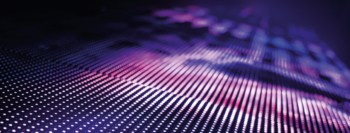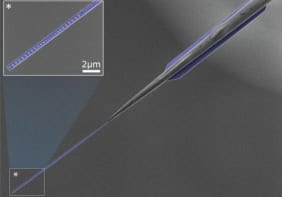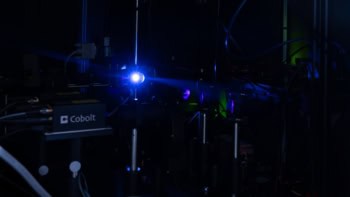Researchers in France and Japan have created antispiral waves – in which the spiral rotates inwards rather than outwards – in a viscous liquid as it flows through an array of fine holes. Such antispiral waves are rarely seen in physical systems, and the scientists hope that their experimental set-up could offer an insight into certain astrophysical phenomena – particularly rotating galaxies that appear to follow an antispiral pattern.
While spiral waves are commonly found in nonlinear optical, biological and chemical systems, the arms of the spiral usually follow the direction of rotation. As the same suggests, an antispiral rotates in the opposite direction, with the arms leading the rotation.
First predicted more than 20 years ago, antispiral waves remain elusive in real-life systems. Vladimir Vanag and Irving Epstein at Brandeis University in the US first observed antispirals in a reaction-diffusion system in a water-in-oil microemulsion in 2001, while astronomers have found evidence that the rotation of some spiral galaxies can occasionally be led by the arms.
In this new work, Harunori Yoshikawa and Christian Mathis from the University of Côte d’Azur (UCA) in France have shown that antispirals can form spontaneously when silicone oil held in a cylindrical reservoir falls through an array of fine holes at the bottom. As the silicone oil leaks through the holes, a liquid film forms underneath the circular plate. The liquid film becomes destabilized by gravity, causing the liquid to fall down from the plate in droplets, columns or uninterrupted curtains – depending on the size of the plate and rate at which the oil leaks through the holes.
Inwards rather than outwards
When the conditions were right to create falling curtains of liquid, the researchers found that the oil started to inwardly rotate around a central region – forming antispiral waves with up to six spiral arms that could rotate clockwise or counter clockwise. “The size of the holes on the grid plate is so small that it has no effect on the formation of antispirals,” explains Yoshikawa. “The plate diameter, in contrast, affects the patterns. We observed eight-armed antispiral curtains with a 188 mm plate, though we did not report it in the published article.”
Yoshikawa says that the current study was inspired by previous work by Laurent Limat of the Université Paris Diderot and his colleagues. While Limat’s group studied the dynamics of liquid columns falling from the edge of a circular dish, the UCA set-up extends this 1D system into a more generalized 2D arrangement.
According to Limat, who was not involved in this new research, “studies with such a fundamental character should be put in a historical perspective”. He points out that researchers realized a few decades ago that other fluid modes must exist between regular fluid flow and fully turbulent conditions. “In some cases, these modes are dependent on the geometry imposed on the fluid, but also give rise to sometimes surprising geometric patterns that are very impressive,” Limat comments. “It says a lot about the secret links between hydrodynamics, physics and mathematics.”
No induced asymmetry
One surprising feature of the new approach is that there is nothing asymmetrical in the experiment. “The antispiral formation is a very exciting phenomenon because we had nothing that can break the symmetry in the experimental set-up,” says Yoshikawa. “The system is completely symmetric, we did not introduce any perturbations, disturbances or any initial conditions that would favour the formation of something non-symmetric. And yet, what we observed, is a formation of antispirals.”
The viscosity and surface tension of the liquid are key parameters in creating the antispiral pattern. Researchers have tried to perform similar experiments with water, but have never observed any regular pattern formation – possibly due to the inability to form a uniform thin film.
In the UCA system, the mechanisms that underpin pattern formation do not seem to emerge from the film itself, but rather from dynamical processes taking place at the border of the liquid film. The detailed processes that lead to the formation of antispirals are not yet understood, however, and Yoshikawa says that the team now plans to “focus on the theoretical investigations by model equations, such as the Ginzburg-Landau and phase-diffusion equations”.
These investigations, they hope, might suggest possible applications in other fields. Understanding the mechanism of antispiral formation could offer novel insights into self-organization processes occurring in nature, including the antispiral patterns that have been observed in some galaxies.
Limat notes that Mathis was involved in a previous study that observed liquid spirals, but comments that this new work is “a much more thorough and aesthetic study”. He goes on to say that the “photos and videos attached to the article are really spectacular”.
The study is described in Physical Review Letters.



